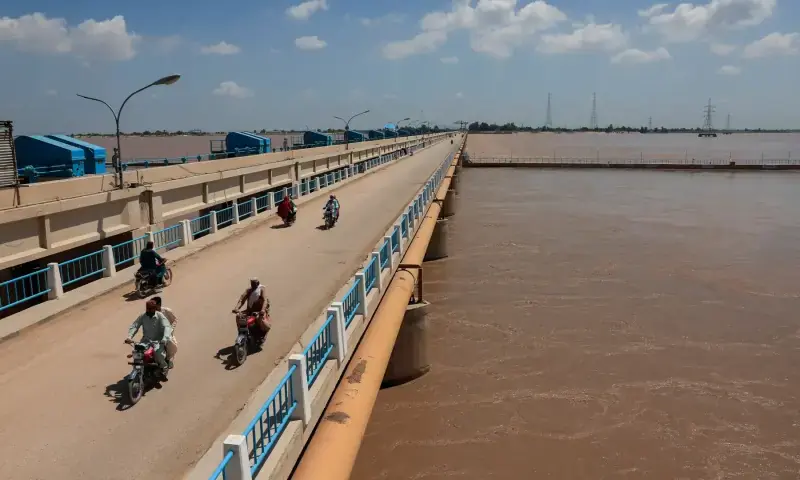By Mohammad Hussain Khan | Khalid Hasnain
Copyright dawn

Sindh officials claim discrepancies in data shared by Punjab authorities
• Punjab seeks proof, says auto and manual systems working accurately
AS THE swollen eastern rivers rage through Punjab towards downstream Sindh, there is some uncertainty about the total inflows at Guddu Barrage in Sindh, with different numbers circulated in the media, causing some measure of confusion.
When the rivers started overflowing last month, the National Disaster Management Authority (NDMA) had estimated that 1.3 million cusecs were expected to hit Guddu.
This claim probably came after over one million cusecs passed through Qadirabad Barrage on the Chenab River on Aug 27.
Guddu, in fact, had first passed a medium flood (390,107 cusecs on July 30) and a high flood (501,299 cusecs on Aug 23 at 12pm). On Aug 24, a peak of 510,798 cusecs flowed through at 12pm.
But statements about a ‘super flood’, high flows in Chenab and multiple breaches across Punjab, caused considerable consternation in Sindh.
Combined with inflows from the Indus, the amount of water heading towards Sindh was initially estimated to be around 900,000 cusecs.
These estimates were then revised downwards, with Sindh chief minister subsequently telling the media that a peak of 650,000 to 700,000 cusecs would be received at Guddu.
Discrepancies?
After hearing reports of discrepancies in flow data, a delegation of Sindh irrigation officials visited Panjnad on Sept 7.
The officials, who spoke to Dawn on condition of anonymity, attributed the confusion about flows to discrepancies in Punjab’s data.
They noted a difference in the gauge installed at Chacharan Bridge in Rahim Yar Khan district. The Chacharan gauge indicates river flow patterns to Sindh before they reach Guddu Barrage.
A Sindh irrigation official shared the correct reading of 11.3ft, in comparison with the 11.7ft reading shared by Punjab during monitoring. “We shared this image with our Punjab counterparts and they then corrected it. This was before Guddu attained its peak of Sept 14,” said an official.
A federal government official, who observes flows in the Indus river system outside of Sindh, seemed to agree with the assessment. “This can possibly be due to the fact that the rating table that helps understand staged discharges was not calibrated, especially at Panjnad, Islam and Sidhnai barrages,” he claimed.
A rating table is the tool used to ensure accuracy in recording stage-wise discharges, and it would appear that the tables at the concerned barrages were not updated to measure a quantum of water over 600,000 cusecs, since such high flows had not been seen here in quite a while. Therefore, an inaccuracy in the measurement of the flows cannot be ruled out.
“Rating tables were not calibrated to record a correct flow at Panjnad [875,000 cusecs designed discharge] so there remains a possibility that correct discharges weren’t shared,” the official said. In his view, there was perhaps no malafide intent behind this error, rather attributing it to administrative inaccuracy.
Another official pointed to “differences” between the automated and manual readings at Panjnad. “We noted SCADA [Supervisory Control and Data Acquisition] had different readings (at Panjnad) while flows recorded manually were different. To us, those readings had an upward variation of 60,000-70,000 cusecs. But this was corrected when the barrage passed the peak of 600,000 cusecs on the evening of Sept 7,” he said.
‘Everything is accurate’
Officials in Punjab, however, rejected the claims made by Sindh officials, saying their automated and manual systems were accurate and that there were no discrepancies recorded at Panjnad, as claimed by Sindh.
“Please ask them whether or not they (Sindh government) have communicated this issue in writing to date? Why are they not writing to us if the discharges are more than the inflows,” Punjab Irrigation Department’s Additional Secretary (Technical) Khurram Amin told Dawn on Monday.
To a question, he said that a high-level delegation from Sindh, including the minister, secretary and other officials had visited Head Panjnad in recent days and checked everything, including the automated and manual reading systems.
He revealed that automated readings in high flood season vary slightly because they are recorded in real-time, so the irrigation department also relies on manual readings for accurate flows.
“To gauge the flows in the high flood season, we always use the left portion of the rivers. This spot is called a gauge well to accurately measure the flows. We chose this area since the rivers flow smoothly here, unlike the flow in the central creek and the right area, where ripples are created, making the officials unable to take manual readings,” he explained.
Rejecting the Sindh team’s claims, he questioned them to explain their observations in writing, telling which reading, manual or sensor, they are talking about. “And even if there is some difference that should not be more than 4/5000 cusecs and is very minor…must not be taken as a big issue,” he said.
Talking to Dawn, Faisal Mushtaq, Bahawalpur irrigation region’s Superintending Engineer, who also deals with the affairs of Head Panjnad, also disagreed with the Sindh observations. “This is very simple to check within a very short time. Gauge inflow and discharge first at Panjand (where Ravi, Chenab and Sutlej gather), then at Chachran Sharif (where these all join the River Indus) and finally at Guddu Barrage.”
“If there is any major difference in the reading at Chachran and Guddu, it means the problem exists on our part. And if there is no difference, it means the problem exists on their part,” he explained. To a question, he said the Sindh team during its visit to Panjnad didn’t express any reservations.
Published in Dawn, September 16th, 2025
Header image: Commuters on motorbikes ride along the Guddu Barrage as floodwater passes through, following monsoon rains and rising levels of Indus River, in Kashmore, Sindh on Sept 13, 2025. — Reuters



